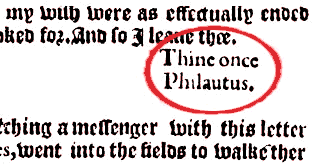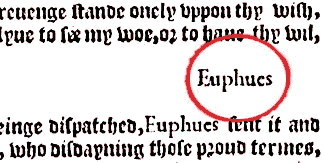
[Image 35]

[Image 36]
UMI ID #
SCT 17051
AUTHOR: Lyly, John
TITLE: Euphues. The anatomy of vvyt
Pages 31 and 32 (Images 35 and 36)
Q: How should we capture the right-justified lines that look like bylines on Images 35 and 36?

[Image 35]

[Image 36]
A: These appear to be signatures to letters quoted within running text; that is, they should recieve the <SIGNED> tag (optionally enclosed within a <CLOSER> tag). The unit to which they should be attached is <LETTER> (this is exactly the situation for which we created the special <LETTER> element).
The first <LETTER> seems to begin with the new paragraph on the bottom of p. 29b (= image 34, left page), and to end with the signature ("Thine once Philautus") on p. 31a (image 35, right page):
<HI>Philautus</HI> ... began to write to
<HI>Euphues</HI> as followeth:</P>
<LETTER>
<P>Althoughe hetherto <HI>Euphues</HI> I
haue shrined thée in my heart for
a trustie friende, I will shunne thée
héerafter as a trothles foe, and although
I cannot sée in <PB REF="34" N="30">
thee lesse witte then I was wont, ...
... And so I leaue thée. </P>
<SIGNED>Thine once Philautus.</SIGNED></LETTER>The second letter is the reply, begining on p. 31a (image 35, right page), and ending on p. 32a (image 36, right page):
<LETTER>
<P>I remember <HI>Philautus</HI> how valyauntly
<HI>Aiax</HI> boa sted in the feats of armes,
yet <HI>Vlysses</HI> bare away the armour ...... and so farewell. </P>
<SIGNED>Euphues</SIGNED></LETTER>I realize that these letters are buried in running text, without any clear sign of a beginning point. I suppose the lesson is that no only headings but also "footings" (stuff that apears to end a structural unit) should be consulted when trying to identify structural divisions in the book. The signatures here are clues that something (probably something worth tagging) is ending at this point.